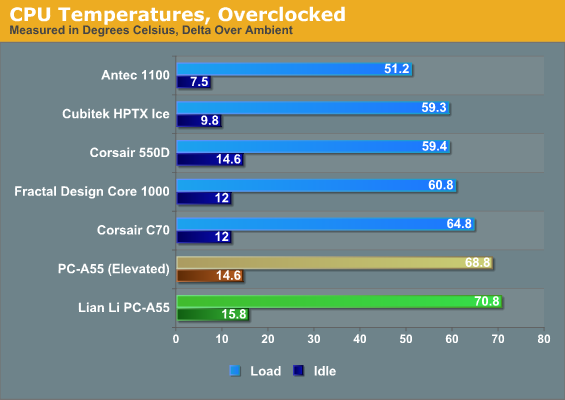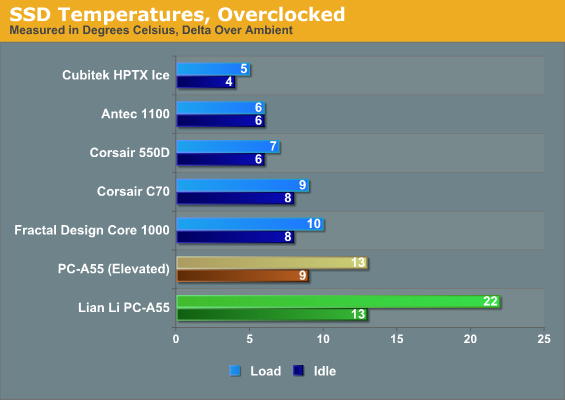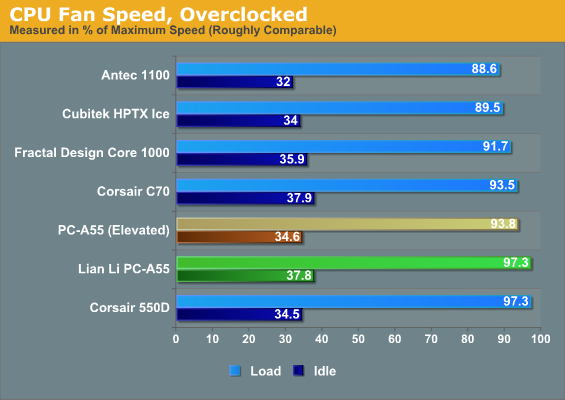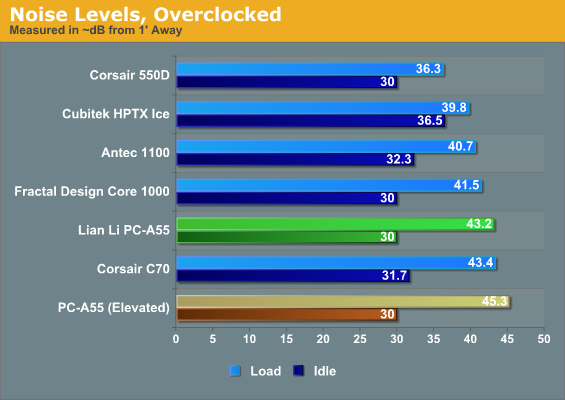Lian Li PC-A55 Case Review: Unfortunate Name Befits the Design
by Dustin Sklavos on June 16, 2012 12:30 PM EST- Posted in
- Cases/Cooling/PSUs
- mid-tower
- Lian Li
- ATX
Noise and Thermal Testing, Overclocked
Lian Li's PC-A55 is the first time I've actually been nervous about thermally testing a case. The CPU cores were already pushing the mid-to-high 80s at stock settings under load; how was this whole thing going to fare when I bumped up the clocks and pumped more voltage through the CPU and graphics card? As it turns out, it wasn't going to fare well at all, and I'm thankful we live in an era where our hardware has thermal protections in place. Ten years ago, I likely would've had to replace most of the testbed after this.



On the charts it doesn't look as bad, but keep in mind that the Intel Core i7-2700K's cores were actually hitting 95C with the case elevated, and 98C without. The GeForce GTX 560 Ti was also peaking at 95C. All of this in a room with an ambient temperature of about 24C, a temperature which isn't terribly uncomfortable or unreasonable. If the PC-A55 had a hard time dealing with a stock system, it flat out couldn't deal with any kind of overclocking. What's worse, look at how heat builds up around the SSD and imagine what would happen if a mechanical drive were used.


Our Cooler Master Hyper 212 Evo was being pushed as hard as it possibly could and the CPU thermals were still hitting the maximum spec. The normally efficient custom cooler on the ASUS GeForce GTX 560 Ti had just as hard a time, with the fan basically maxing out under load. Lian Li's design has virtually no thermal headroom. With the elevated testbed, the GPU does better, but even so it places last out of our set of cases.

The PC-A55 basically winds up being our worst-case scenario on almost all fronts. While it remains quiet at idle, under load it's very noisy and uncomfortable to listen to, due to the fact that the fans running inside are all going at full bore. As a side note, because of the aluminum shell, the top of the case was actually almost painfully hot to the touch when tested under these conditions. Putting the case on a flat surface helped thermals a bit, but also gave noise one more place to escape, causing it to run even louder.










64 Comments
View All Comments
Bitmap - Tuesday, June 19, 2012 - link
I laughed my A55 offMadAd - Wednesday, June 20, 2012 - link
"We're at a juncture now where there are very few reasons to go with an ATX motherboard over a Micro-ATX board"Exactly!! PC form factors need a reboot if they are to survive the next 10 years onslaught of tablets. ITX is a fantastic format limited only by its 17x17 size allowing only a single expansion slot and 2 channels of ram - and that really makes sense when paired with a low profile card in a thin case ... as soon as we need some HDDs, or a larger graphic card, or a soundcard and a graphics card then theres a big void between that and the 4 slot uATX format, filled only by the defunct DTX format (that imo with only 2 slots really didnt give much more of an option to ITX.)
My ideal board would have 3 expansions, 2x16 and 1xPCI, 4 Ram Slots and 6 Satas in a size not much bigger than ITX however this is all moot since the biggest problem is elsewhere too, we still have a problem with things like PSUs, they need to be smaller, same with Optical RW drives, do we need more than a laptop slimline size for opticals?
The first CD i burned in the last century was in a 5.25" bay, while we cant do anything about the width of the disk certainly it could slimline allowing sideways mounting yet there are no standard mountings for slimline Optical drives in the ATX spec.
Apart from the wishful thinking I do believe its time to step down from these humongous tower cases. I am already planning my next build into a uATX but of course anandtech doesnt really cover uATX stuff now does it *grin*
rickcain2320 - Thursday, June 21, 2012 - link
I have the previous version of this case and it has a severe hot spot at the top. The addition of the exhaust fan at the top hopefully resolves this problem. They rotated the power supply so it blows in rather than out (I guess) which is good, because the old fan direction was right over the hard drives, bathing them in warm air from your GPU and CPU. I regularly kept my front panel off because of overheating.Makes me wonder if I do some minor surgery and flip my fans over, could I achieve something similar?
manythings - Tuesday, October 20, 2015 - link
I have read this several times and still didn't get the joke about the name of the unit. Is it about being "PC"? But every Lian Li case is a PC. Could the author explain the joke? Thanks